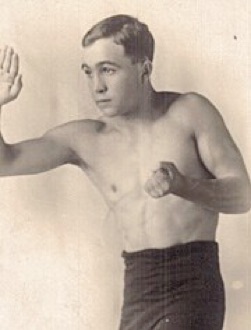


It may just be that the old saying of, "Good things come in small packages", was coined by someone who watched Minnesota's first world Champion fight. Standing just 4' 11" tall, but with a trunk-like waist, and strong round shoulders, Johnny "Kewpie" Ertle was a small package indeed, but a package loaded with dynamite, that when shook…made a whole lot of noise.
Nick-named, "Kewpie" for his baby-faced appearance and small size, Johnny Ertle emerged onto the professional boxing scene at a time full of talented Bantamweights. His first pro fight came under the watchful management of Mike McNulty, and occurred on October 31, 1913 on a "sneak-fight" card in St. Paul. Since boxing was still illegal in Minnesota at the time, and Johnny was just 16, news of the bout had to be kept secret. But the whirlwind style and savage hooks that "Kewpie" ripped to Joe LaScotte's ribs and jaw, were anything but quiet. He stopped LaScotte in the 3rd round and picked up many fans in the process. Embarrassed that it appeared he had lost to child, LaScotte again challenged Johnny to an immediate rematch the following month. Again, Ertle turned the trick, knocking Joe out in 4 heats. McNulty realized that he had diamond in the rough in Ertle. He took Johnny to Wisconsin where the sport was legal in order to get more experience, and the "Kewpie" developed at such a rate, that newswires across the country soon began speaking of McNulty's Bantamweight prize attraction. By the end of 1914, little Johnny was a star, and had an unblemished record (including newspaper decision contests) of 18-0. Johnny was an especially dangerous body puncher due to the leverage he could exert with his unique height in relation to his opponents torso. Talk was already beginning of him challenging for the World's title.
Ertle continued his meteoric rise to the top of the Bantamweight ranks by running off another 7 consecutive victories before tasting his first ever defeat, and that being at the hands of future champion, Memphis Pal Moore in April of 1915, a fight that was quite controversial at the time, as it occurred in Moore's hometown of Memphis, and with his manager's friend serving as referee. Most newspapermen saw Ertle winning the fight, but Tennessee allowed official decisions and the referee ruled in favor of Moore. Ertle shook off controversial loss and rattled off three straight wins, including two big ones over fellow contender, Eddie Coulon. These wins set up a match with Kid Williams for his World Bantamweight title. The fight was fairly even going into the 5th round, but Williams who had already been repeatedly warned by referee George Barton for his foul tactics, kept on with his elbows and low blows, one of which went greatly hurt Ertle, causing Barton to disqualify Williams. Though no champion likes to lose their title by being disqualified, it had happened before in boxing history, and according to Minnesota law in 1915, no official decision could be rendered unless by DQ or KO, in which case the state would honor the verdict because it was undeniable and without question. And with that, the title changed hands and Johnny Ertle was the new Bantamweight Champion of the World!
Controversy soon ensued. Williams' manager, the very powerful Sam Harris, traveled back home to Baltimore and convinced all the largest newspapers out East, that Williams had been beating Ertle so badly, including scoring several knockdowns, that Ertle was looking for a way out and faked his injury. Harris also stated that because Minnesota did not allow official decisions, Williams was still champion. Keep in mind that this fight occurred before the days or radio, internet, or television to double-check facts, and being one of the most famous boxing managers in the country, no one out East doubted the authenticity of Harris' words and kept acknowledging Kid Williams as the champion. These lies filtered back to Minnesota and scathing articles blasted both Williams and Harris for causing these untruths, and consequently, a great schism in the Bantamweight division as to whom the real champion was, which by rights (and law), was now Johnny Ertle. But lacking the sort of influence that Harris carried, McNulty and "Kewpie" forever had to defend their claim to the Bantamweight title, and many states listened and acknowledged him as such, but not all, and not the most important states in boxing such as New York.
Ertle continued to defend his rightful title until losing it justly at the hands of Memphis Pal Moore in 1918, but not before traveling over to Kid Williams' hometown of Baltimore to see who the "real" champion really was in 1917. Ertle twice knocked down Williams but was only able to secure a Draw verdict, as even the Baltimore crowd booed loudly. Johnny continued fighting through 1919 and then tired of all the games and screwy decisions, retired and took up farming. But shortly after his daughter was born, he felt reinvigorated and decided to make a comeback in 1920, his first opponent being his arch enemy, Kid Williams. This time Williams beat him fair and square, as Johnny could not shake off the year of ring rust and lost the 12 round decision. He continued fighting with mixed results, but now in the heavier Featherweight division, until he showed glimpses of his prime form by beating Saph McKenna over 10 hard rounds in 1923. But for all practical purposes, Johnny was finished as boxer. He fought four more times, going just 1-3, and then called it quits for good. Combining his official record with his fights from states that left it up to the newspapers to decide the outcomes, Ertle's record rates right up there with the best of the Bantamweights of history, going 62-20-6 over an 11 year career. Tonight we honor our first champion, who looked like a boy among men, but fought like a man among boys.

